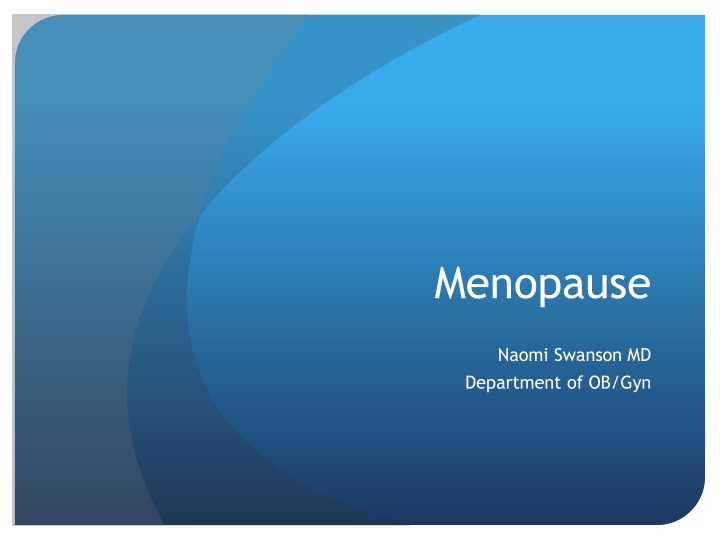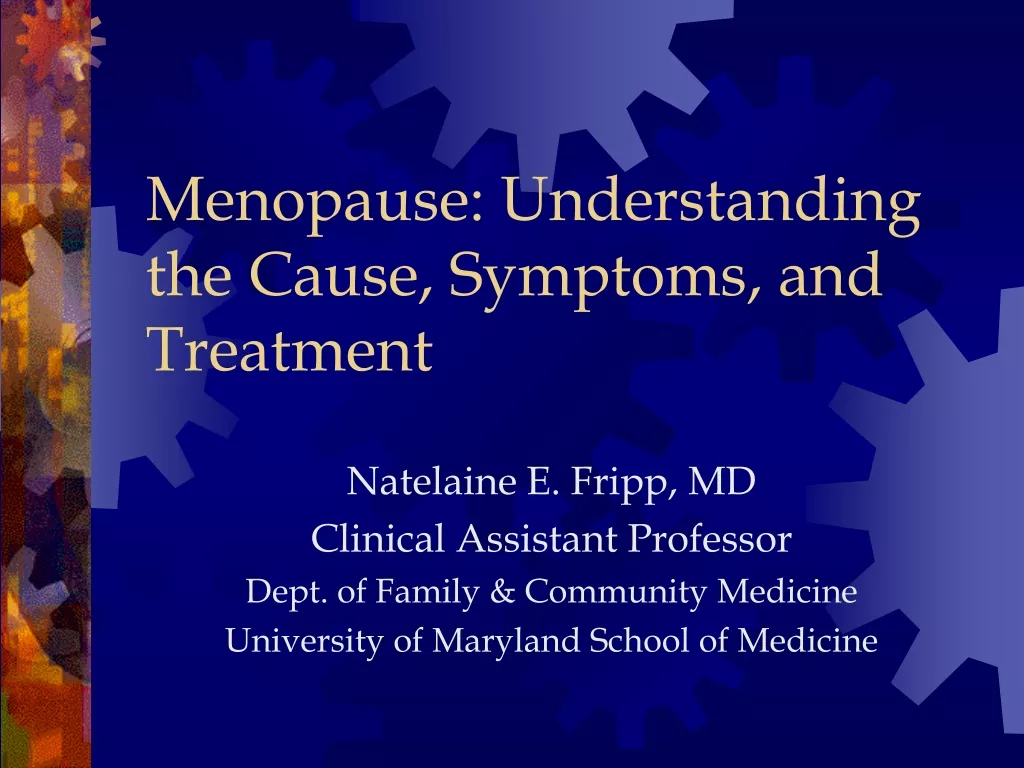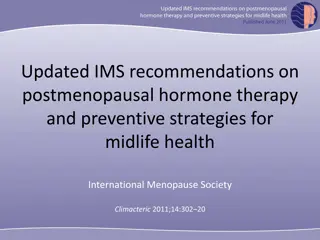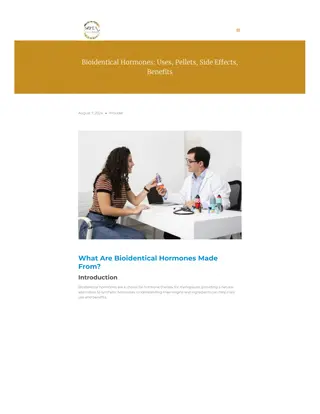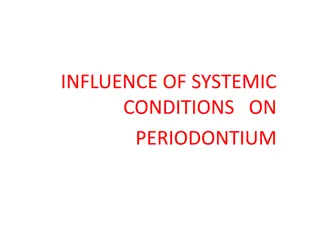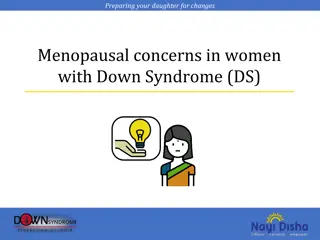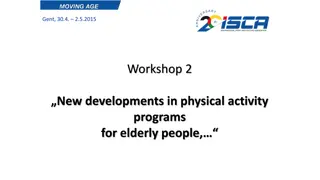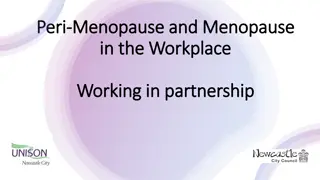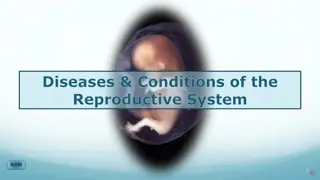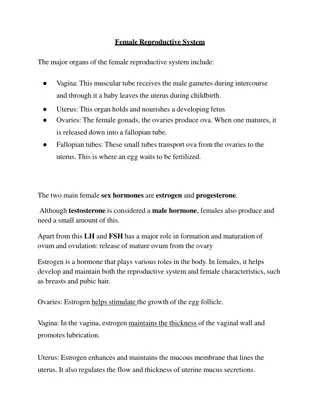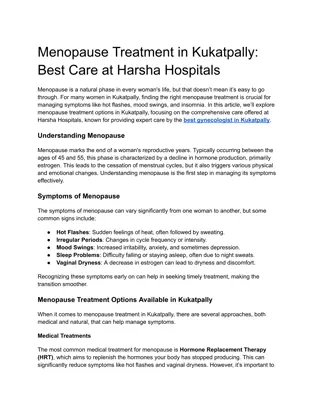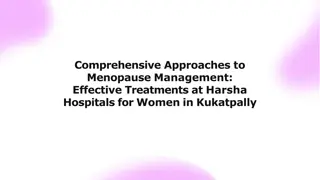Menopause
In menopause, women experience cessation of menses and vasomotor symptoms like hot flushes. Hormone replacement therapy can alleviate symptoms but poses risks. Understanding contraindications, routes of therapy, and alternatives is essential. Genitourinary syndrome of menopause and treatment options are key considerations. Exploring the timing hypothesis for cardio-protection with early HRT use adds depth to the menopause management discussion.
Download Presentation

Please find below an Image/Link to download the presentation.
The content on the website is provided AS IS for your information and personal use only. It may not be sold, licensed, or shared on other websites without obtaining consent from the author.If you encounter any issues during the download, it is possible that the publisher has removed the file from their server.
You are allowed to download the files provided on this website for personal or commercial use, subject to the condition that they are used lawfully. All files are the property of their respective owners.
The content on the website is provided AS IS for your information and personal use only. It may not be sold, licensed, or shared on other websites without obtaining consent from the author.
E N D
Presentation Transcript
Menopause Naomi Swanson MD Department of OB/Gyn
Menopause Objectives Define menopause. List benefits and risks of hormone replacement therapy (HRT). Identify contraindications to hormone replacement therapy. List various routes of HRT and their associated risks and benefits. List alternatives to HRT and their associated risks and benefits. Define Genitourinary Syndrome of Menopause and list options for treatment.
Menopause Cessation of menses for 12 months Median Age = 51 FSH>70 Perimenopause=climacteric=menopausal transition
Menopause Vasomotor Symptoms The Hot Flush Flushing, perspiration, chills, claminess, anxiety and heart palpitations Interrupt sleep 87% of women who report hot flushes report daily symptoms Wide variation in duration
Menopause The Hot Flush Risk Factors Ethnicity African American women report most, Asian women the least (Women s Health Across the Nation Study 2006) Obesity Depression Anxiety Low Socioeconomic Status Smoking
Hormone Replacement Therapy HRT leads to a 75% reduction in weekly hot flushes Adverse side effects Breast tenderness Vaginal bleeding Bloating Headaches
Hormone Replacement Therapy Women s Health Initiative Primary aim was to determine whether HRT could be used for primary prevention of cardiovascular disease. Mean age of women 63 Showed an increase risk of cardiovascular events in women using combined HRT after 5 years
Timing Hypothesis Increasing evidence suggests that use of HRT in early menopause provides a cardio-protective benefit. - Reanalysis of WHI participants aged 50-59 shows a possible cardio protective effect - WHI Coronary Artery Calcium showed decreased coronary artery calcification in women using estrogen therapy for over 5 years.
Hormone Replacement Therapy Manson et al.
Hormone Replacement Therapy Contraindications Active liver disease History of DVT/PE, Stroke/TIA, CHD Known thrombophilia Untreated/Uncontrolled HTN Breast cancer Endometrial Cancer Unexplained vaginal bleeding Relative contraindications Elevated triglycerides Gallbladder disease
Routes of Therapy Oral Non Oral Transdermal Patch Sprays Gels/creams Vaginal ring -Little to no effect in elevating prothrombotic factors due to lack for first pass effect. -Estrogen and Thromboembolism Risk study showed no increase risk of venous thromboembolism in transdermal estrogen users Intrauterine
Hormone Replacement Therapy Progesterone Limited data to suggest superiority Increased risk of breast cancer Synthetic progesterone has vasoconstrictive effect Natural (Micronized) progesterone has vasodilatory effect Testosterone No benefit for hot flushes Improved sexual function scores with HT Adverse effects Lipids Clitoromegally Hirsutism Acne
Compounded Bio-identical Hormones Plant derived, similar chemical structure Not tested for potency, purity or safety Evidence to support superiority is lacking Under dosing and Overdosing due to variable bioavailability and bioactivity Hormone level testing with saliva is not indicated nor reliable
Alternative Therapies SSRI/SSNRI - Positive effect on hot flushes - Adverse effects: Nausea, dizziness, somnolence, nervousness, sexual dysfunction Complimentary and Natural Therapies - Efficacy data is lacking - No data for long term effects Clonidine - Positive benefit on hot flushes - Adverse effects: Dry mouth, insomnia, drowsiness Accupuncture - Efficacy data is lacking Gabapentin - Positive effect on hot flushes - Adverse effects: Somnolence, dizziness, edema Lifestyle Modification - Clothing - Decreased caffeine and ETOH
Genitourinary Syndrome of Menopause External Genital Sequelae Urologic Sequelae Sexual Dysfunction
Genitourinary Syndrome of Menopause Lower estrogen states leads to loss of superficial epithelial cells which causes thinning of the vaginal mucosa and narrowing and shortening of the vaginal vault Dryness, discharge, itching, dyspareunia Loss of subcutaneous fat in the labia majora Vaginal pH increases
Treatment of GSM Systemic HRT Local vaginal estrogen - fastest and most effective Not associated with increased risk of endometrial hyperplasia SERM (Ospemafene) FDA approved Adverse effects: Vaginal discharge, hot flushes, muscle spasms, thromboembolism.
Treatment of GSM - Fractional Micro-ablative CO2 Laser Therapy Mona Lisa Touch Early studies show high satisfaction and return to normal sexual function No long term data
Treatment of GSM contd Tibolone Synthetic Steroid Oxytocin Gel Lubricants Homeopathic therapies Sex Use it, don t lose it
Conclusions Early treatment of menopause symptoms with hormone replacement has overall low risk with high benefits. Treatment of menopause symptoms should be individualized taking in to account a woman s risk factors and the impact of symptoms on her quality of life.
Naomi Swanson MD NSwanson@salud.unm.edu 380-0912
References/Resources ACOG Practice Bulletin Number 141, January 2014, Reaffirmed 2016. Management of Menopausal Symptoms. ACOG Committee Opinion Number 556, April 2013. Reaffirmed 2015. Postmenopausal Estrogen Therapy: Route of Administration and Risk of Venous Thromboembolism. ACOG Committee Opinion Number 532, August 2012, Reaffirmed 2016. Compounded Bioidentical Menopausal Hormone Therapy. ACOG Committee Opinion Number 565, April 2013, Reaffirmed 2015. Hormone Therapy and Heart Disease. The North American Menopause Society The 2017 hormone therapy position statement of the North American Menopause Society. Menopause. 2017; 24: 728-753. Gandhi J, et al. Genitourinary syndrome of menopause: an overview of clinical manifestations, pathophysiology, etiology, evaluation, and management AJOG. Dec 2016; 215 (6): 704-711. Bhupathiraju S et al, Exogenous Hormone Use: Oral Contraceptives, Postmenopausal Hormone Therapy, and Health Outcomes in the Nurses Health Study Am J Public Health. 2016; 106:1631-1637. Lobo, R. Hormone-replacement therapy: current thinking Nature Reviews Endocrinology. 2017; 13: 220-231 Kaunitz A, Manson J. Management of Menopausal Symptoms Obstetrics and Gynecology. 2015; 126 (4): 859-876. Manson J., Kaunitz A. Menopause Management Getting Clinical Care Back on Track The New England Journal of Medicine. 2016 374 (9): 803806
